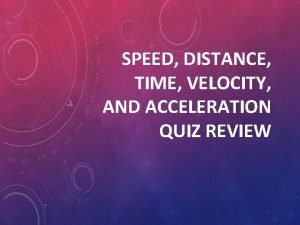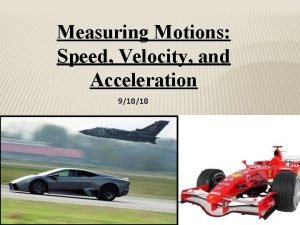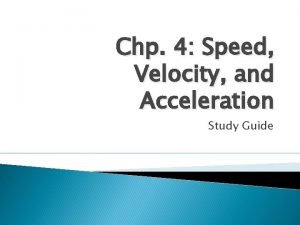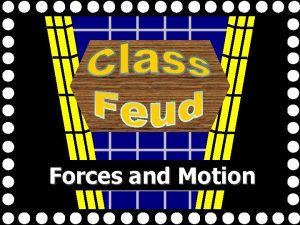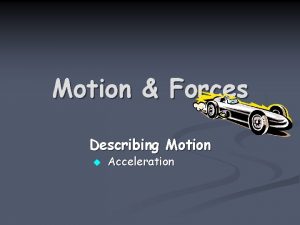Forces and motion revision Keywords Speed velocity acceleration




- Slides: 4

Forces and motion revision Keywords: Speed, velocity, acceleration, Newton, thinking distance, braking distance, stopping distance Do Now: 1. Usain Bolt’s 100 m world record is run in a time of 9. 58 s. Calculate his average speed during the race. 2. Calculate his average kinetic energy during this race (his mass is 94 kg). Speed, velocity and acceleration Speed is a scalar, while velocity is a vector. They both can be calculated using the equation v=s÷t v is the velocity or speed (in m/s) s is the distance (in m) t is the time (is s) The average person walks at a speed of 1. 5 m/s, runs at a speed of 3 m/s and cycles at a speed of 6 m/s. The speed of sound in air is 330 m/s. Acceleration is a vector and is the rate of change of velocity. Acceleration = Change in velocity ÷ Time taken (a = Δv ÷ t) Acceleration has units of m/s 2 v 2 - u 2 = 2 × a × s where v = final velocity (in m/s) u = initial velocity (in m/s) a = acceleration (in m/s 2) s = distance (in m)

Distance-time and velocity-time graphs A distance-time graph can be used to see when an object is stationary or travelling at a constant speed. The steeper the slope, the faster the speed. The speed of the car can be calculated by looking at the gradient of the distance-time graph. (i. e. change in y divided by change in x) A velocity-time graph shows how the velocity of an object changes. Diagonally Up Constant Acceleration Horizontal Constant speed Diagonally Down Constant Deceleration Gradient This is the acceleration of the object. Area under the graph This is the distance travelled by the object.

Newton’s laws Newton’s First Law: If the resultant force acting on an object is zero and: • The object is stationary, the object remains stationary • The object is moving, the object continues to move at the same speed and in the same direction. So the object continues to move at the same velocity. Newton’s Second Law: The acceleration of an object is proportional to the resultant force acting on the object, and inversely proportional to the mass of the object. So, when a vehicle travels at a steady speed the resistive forces balance the driving force. Newton’s Third Law: Whenever two objects interact, the forces they exert on each other are equal and opposite. So, the velocity (speed and/or direction) of an object will only change if a resultant force is acting on the object. Force = mass x acceleration F=m×a

Forces and braking The stopping distance of a car is the minimum distance that a car can safely stop in. It is made up of the thinking distance and the braking distance. Stopping distance = thinking distance + braking distance The thinking distance is the distance travelled by the vehicle in the time it takes for the driver to react The breaking distance is the distance travelled by the vehicle during the time the braking force acts Reaction times vary from person to person. Typical values range from 0. 2 s to 0. 9 s. When a force is applied to the brakes of a vehicle, work done by the friction force between the brakes and the wheel reduces the kinetic energy of the vehicle and the temperature of the brakes increases. The greater the speed of a vehicle the greater the braking force needed to stop the vehicle in a certain distance.
